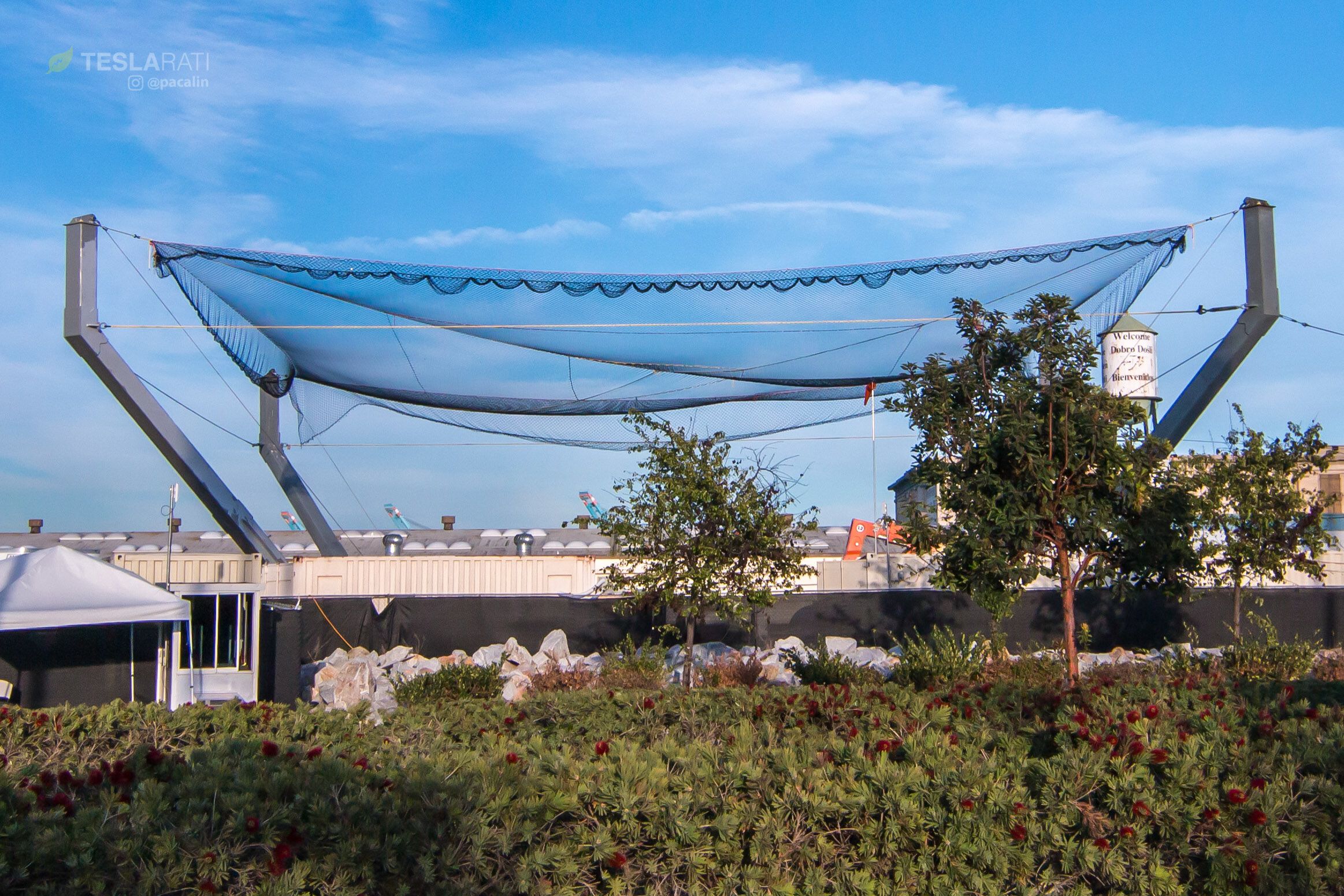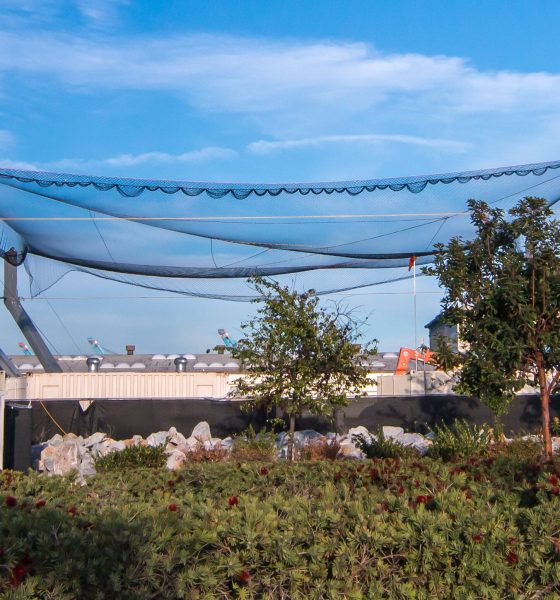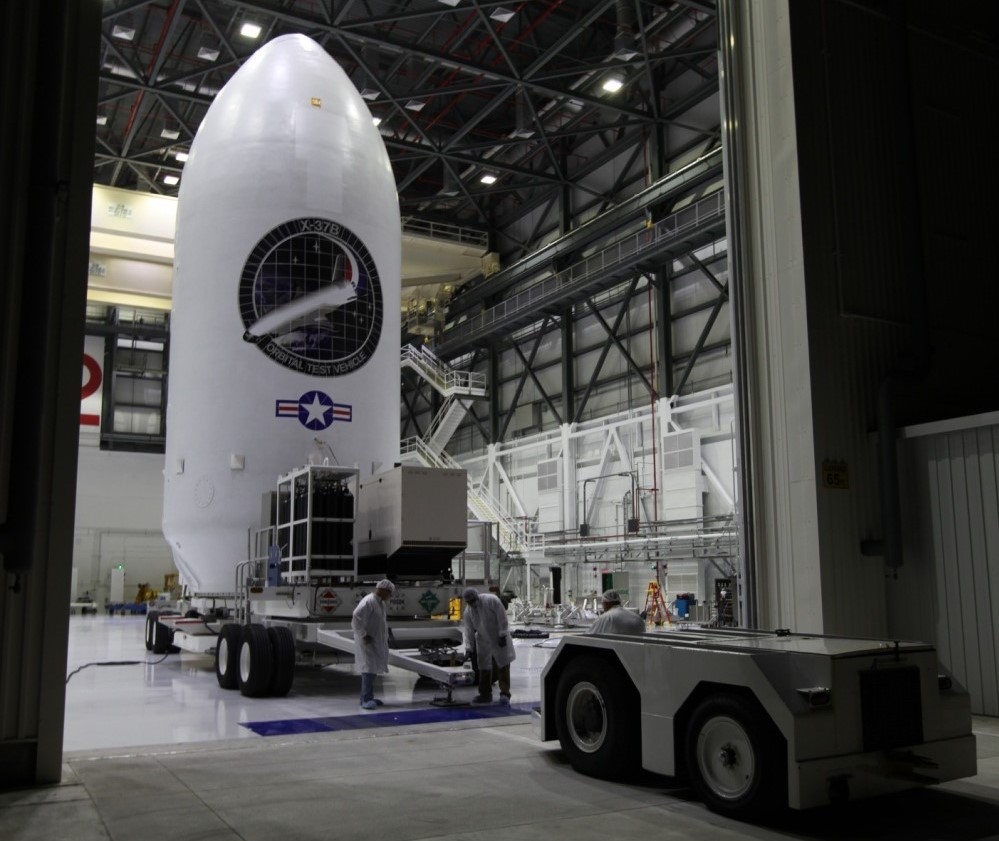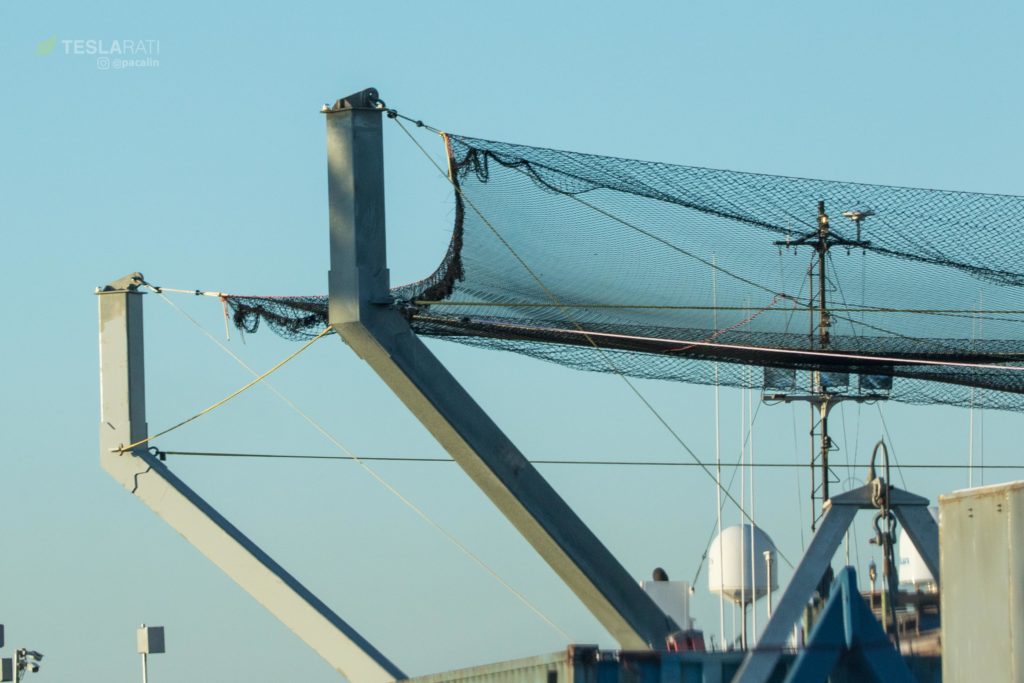

News
SpaceX’s claw-boat ready to recover rocket fairing with a giant net
Teslarati’s West coast photographer Pauline Acalin has captured some amazing photos of one of SpaceX’s most immediately recognizable fairing recovery vessels berthed in the Port of San Pedro. For the first time ever, the vessel (officially named Mr. Steven) has had its iconic claw rigged with a massive net intended to gently capture Falcon 9 payload fairings.
SpaceX has been trying in earnest to recover its rockets’ fairings for approximately one year, but has yet to recover a fairing intact. While the company appeared to have recovered at least one large fragment on the East coast, success has proven elusive, and CEO Elon Musk noted in press conferences before and after Falcon Heavy’s inaugural launch that the task had proven more difficult than was anticipated. Despite the difficulties, SpaceX has no intention of surrendering their valuable fairings (a $5 million pallet of cash, as Musk once joked) to the sea.
- Imagine this building-sized fairing traveling approximately TWO MILES PER SECOND. (USAF)
- Mr Steven’s big ‘ole net and iconic claws hunger for Falcon fairings. (Pauline Acalin/Teslarati)
Along with the imminent introduction of SpaceX’s upgraded “Fairing 2.0” on the upcoming Wednesday launch of PAZ, chances of a successful fairing recovery are almost certainly higher than ever before. While SpaceX and CEO Musk has only revealed that the upgraded fairing is somewhat larger than its predecessor, it can also be more or less guaranteed that its aforementioned upgrades go well beyond larger dimensions, likely extending into improved reusability hardware, greater ease of manufacture, and much more. This should come as no surprise – SpaceX has a long and storied history of making constant, iterative improvements to all aspects of itself, be it hardware, software, design, or manufacturing.

Mr. Steven’s fancy new net captured in the golden hour before sunset at L.A.’s Port of San Pedro. (Pauline Acalin/Teslarati)
Enter Mr. Steven’s fancy new netting. While no bouncy castle, a highly maneuverable vessel with an effortlessly reusable net is arguably far superior to a dead-in-the-water piece of inflatable plastic. As the fairing (theoretically) floats gently down to the surface of the ocean under its guided parachute, Mr. Steven’s coxswain will be tasked with skillfully maneuvering the boat to account for any the sea state and any winds in order to maintain its position at the fairing’s destination. If all goes well, at least half of Falcon 9’s payload fairing will gently drop into Mr. Steven’s net, marking SpaceX’s first successful recovery. If things don’t go exactly as planned, a 1000kg hunk of metal and composite could theoretically smash into poor Mr. Steven at an unhealthy velocity. However, things are looking considerably more positive this time around.
SpaceX’s fairing grabber, Mr. Steven, a couple days ago preparing to ship out for Wednesday’s launch at Vandenberg. @Teslarati #paz #Starlink pic.twitter.com/lfWjUGy56k
— Pauline Acalin (@w00ki33) February 19, 2018
By all appearances, SpaceX has retained the same general strategy of fairing recovery mentioned in the past by Musk and other executives. To oversimplify, after launch, the payload fairing separates (mechanically) from the second stage once Falcon 9 or Heavy has left behind the majority of Earth’s atmosphere. After separation, each fairing half orients itself for a gentler reentry into the atmosphere with cold nitrogen gas thrusters, likely the exact same thrusters used in part to achieve Falcon 9’s accurate and reliable landings. Due to their massive surface area and comparatively tiny weight, fairing halves effectively become exceptionally finicky and awkward sails falling through the atmosphere at insane velocities, with the goal generally being to orient each half like a boat’s hull to provide some stability. Once they are low enough, assuming they’ve survived the journey from TEN TIMES THE SPEED OF SOUND and 62 MILES above Earth’s surface to a more reasonable ~Mach 0.5 and maybe 5 miles of altitude, the fun parts begin. At this point, each fairing half deploys a GPS-connected parachute system (a parasail, to be exact) capable of directing the massive hunks of carbon fiber and aluminum to a very specific point on the surface of the ocean.
Successful fairing recovery would quite literally entail an immediate cost reduction of as much as 10% of a Falcon 9’s entire advertised launch price, ~$6 million. For recovery of a single half, that figure is of course…halved, but $3 million is still an impressive instantaneous cost reduction. It’s unclear how SpaceX eventually intends to recover both halves of the fairing – a Mr. Steven sibling, perhaps? – but that is a problem for future SpaceX!
Mr. Steven and his net are likely to get their first taste of action in just two days – PAZ and two of SpaceX’s very own prototype internet satellites are set to launch at 6:17 am PST on Wednesday, February 21. Stay tuned for a link to SpaceX’s official webcast and follow us on social media for down-to-the-minute updates.
Teslarati – Instagram – Twitter
Tom Cross – Twitter
Pauline Acalin – Twitter
Eric Ralph – Twitter
https://twitter.com/_TomCross_/status/965394574578540545

News
Tesla FSD fleet is nearing 7 billion total miles, including 2.5 billion city miles
As can be seen on Tesla’s official FSD webpage, vehicles equipped with the system have now navigated over 6.99 billion miles.

Tesla’s Full Self-Driving (Supervised) fleet is closing in on almost 7 billion total miles driven, as per data posted by the company on its official FSD webpage.
These figures hint at the massive scale of data fueling Tesla’s rapid FSD improvements, which have been quite notable as of late.
FSD mileage milestones
As can be seen on Tesla’s official FSD webpage, vehicles equipped with the system have now navigated over 6.99 billion miles. Tesla owner and avid FSD tester Whole Mars Catalog also shared a screenshot indicating that from the nearly 7 billion miles traveled by the FSD fleet, more than 2.5 billion miles were driven inside cities.
City miles are particularly valuable for complex urban scenarios like unprotected turns, pedestrian interactions, and traffic lights. This is also the difference-maker for FSD, as only complex solutions, such as Waymo’s self-driving taxis, operate similarly on inner-city streets. And even then, incidents such as the San Francisco blackouts have proven challenging for sensor-rich vehicles like Waymos.
Tesla’s data edge
Tesla has a number of advantages in the autonomous vehicle sector, one of which is the size of its fleet and the number of vehicles training FSD on real-world roads. Tesla’s nearly 7 billion FSD miles then allow the company to roll out updates that make its vehicles behave like they are being driven by experienced drivers, even if they are operating on their own.
So notable are Tesla’s improvements to FSD that NVIDIA Director of Robotics Jim Fan, after experiencing FSD v14, noted that the system is the first AI that passes what he described as a “Physical Turing Test.”
“Despite knowing exactly how robot learning works, I still find it magical watching the steering wheel turn by itself. First it feels surreal, next it becomes routine. Then, like the smartphone, taking it away actively hurts. This is how humanity gets rewired and glued to god-like technologies,” Fan wrote in a post on X.
News
Tesla starts showing how FSD will change lives in Europe
Local officials tested the system on narrow country roads and were impressed by FSD’s smooth, human-like driving, with some calling the service a game-changer for everyday life in areas that are far from urban centers.

Tesla has launched Europe’s first public shuttle service using Full Self-Driving (Supervised) in the rural Eifelkreis Bitburg-Prüm region of Germany, demonstrating how the technology can restore independence and mobility for people who struggle with limited transport options.
Local officials tested the system on narrow country roads and were impressed by FSD’s smooth, human-like driving, with some calling the service a game-changer for everyday life in areas that are far from urban centers.
Officials see real impact on rural residents
Arzfeld Mayor Johannes Kuhl and District Administrator Andreas Kruppert personally tested the Tesla shuttle service. This allowed them to see just how well FSD navigated winding lanes and rural roads confidently. Kruppert said, “Autonomous driving sounds like science fiction to many, but we simply see here that it works totally well in rural regions too.” Kuhl, for his part, also noted that FSD “feels like a very experienced driver.”
The pilot complements the area’s “Citizen Bus” program, which provides on-demand rides for elderly residents who can no longer drive themselves. Tesla Europe shared a video of a demonstration of the service, highlighting how FSD gives people their freedom back, even in places where public transport is not as prevalent.
What the Ministry for Economic Affairs and Transport says
Rhineland-Palatinate’s Minister Daniela Schmitt supported the project, praising the collaboration that made this “first of its kind in Europe” possible. As per the ministry, the rural rollout for the service shows FSD’s potential beyond major cities, and it delivers tangible benefits like grocery runs, doctor visits, and social connections for isolated residents.
“Reliable and flexible mobility is especially vital in rural areas. With the launch of a shuttle service using self-driving vehicles (FSD supervised) by Tesla in the Eifelkreis Bitburg-Prüm, an innovative pilot project is now getting underway that complements local community bus services. It is the first project of its kind in Europe.
“The result is a real gain for rural mobility: greater accessibility, more flexibility and tangible benefits for everyday life. A strong signal for innovation, cooperation and future-oriented mobility beyond urban centers,” the ministry wrote in a LinkedIn post.
News
Tesla China quietly posts Robotaxi-related job listing
Tesla China is currently seeking a Low Voltage Electrical Engineer to work on circuit board design for the company’s autonomous vehicles.

Tesla has posted a new job listing in Shanghai explicitly tied to its Robotaxi program, fueling speculation that the company is preparing to launch its dedicated autonomous ride-hailing service in China.
As noted in the listing, Tesla China is currently seeking a Low Voltage Electrical Engineer to work on circuit board design for the company’s autonomous vehicles.
Robotaxi-specific role
The listing, which was shared on social media platform X by industry watcher @tslaming, suggested that Tesla China is looking to fill the role urgently. The job listing itself specifically mentions that the person hired for the role will be working on the Low Voltage Hardware team, which would design the circuit boards that would serve as the nervous system of the Robotaxi.
Key tasks for the role, as indicated in the job listing, include collaboration with PCB layout, firmware, mechanical, program management, and validation teams, among other responsibilities. The role is based in Shanghai.
China Robotaxi launch
China represents a massive potential market for robotaxis, with its dense urban centers and supportive policies in select cities. Tesla has limited permission to roll out FSD in the country, though despite this, its vehicles have been hailed as among the best in the market when it comes to autonomous features. So far, at least, it appears that China supports Tesla’s FSD and Robotaxi rollout.
This was hinted at in November, when Tesla brought the Cybercab to the 8th China International Import Expo (CIIE) in Shanghai, marking the first time that the autonomous two-seater was brought to the Asia-Pacific region. The vehicle, despite not having a release date in China, received a significant amount of interest among the event’s attendees.










